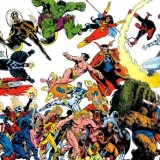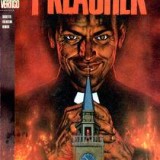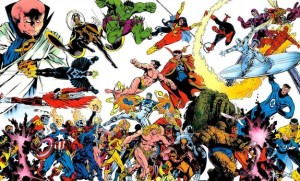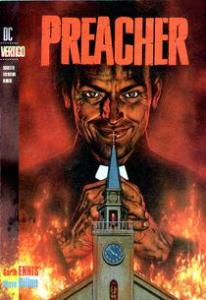Marvel Universe is Ending

The Marvel Universe is ending. At least that’s the latest from Marvel. With the publication of Secret Wars #1 in May, the entire Marvel line will be part of Battleworld. What will all this mean? I guess we’ll have to wait and see. You can read more of the interview at Newsarama here.
Overstreet Guide to Grading Comics 2015 Review
Last week I received my Overstreet Guide to Grading Comics 2015 edition from Amazon. I consider the grading guide a must have resource for serious comic book collectors or investors and I’ll take a few minutes to review this latest edition.
Why is this a must have resource? I think Bob Overstreet sums it up best in his Foreword:
Accurate grading of comic books has never been more important because the stakes have never been higher.
How right he is! A two tenth difference in grade can mean thousands to tens of thousands of dollars in the value of a comic book. He goes on:
If you grade your own comics, you need to know what you’re doing. If you use third party grading services the same is still true…one should approach them with reasonable, informed expectations when submitting.
I couldn’t agree more.
This is the fourth edition of the Grading Guide, the first was in 1992 revealing the 100 point scale, again in 2003 updating to a 10 point scale, then finally in 2006. The guides have been broken down into the same basic sections with each edition. The major sections include:
– Introduction
– The Evolution of Grading
– Using the 10 point scale
– Diagram of a Comic Book
– Grading Definitions
– Comic Book Restoration
– How to Describe a Comic Book
– How to Grade a Comic Book
– Third Party Profiles
– Restoration Overviews by both CGC and CBCS
– Preserving your comic books
– Special Collections
– The Comic Book Ages
– Grading Section
Let’s a take a closer look at some of the sections.
The Evolution of Grading, Using the 10 Point Scale, Diagram of a Comic Book and Definitions
The Evolution of Grading gives the novice an overview about how the comic book hobby got to where we are now in grading. It’s a concise history and good for some basic knowledge.
The real meat comes in the next sections. This is a great first stop for everyone, from the beginner to long time collector. In Using the 10 Point Scale the grades are explained. This includes the policy on plus and minus grades, the 10 point scale itself, and most importantly the number of allowable defects in each grade. Page 24 presents a graph showing the allowable range of defects for each grade.
The diagram of a comic book on page 26 is important for beginners to know the verbiage collectors use when describing a comic book. Overstreet presents this information in picture form pointing out each part of a comic book along with the correct names.
The Grading Definitions beginning on page 28 is the next important stop. Here you’ll find each numerical point broken down into a paraphrased description of what to expect in a specific comic book grade. For example, “10.0 Gem Mint – This is an exceptional example of a given book…” It also gives the major defects allowed or not allowed at each step.
Comic Book Restoration, How to Describe a Comic Book, How to Grade a Comic Book
If you are buying comic books you’ll eventually run into restoration, either disclosed or undisclosed. In this section you’ll learn some basic types of restoration and very rudimentary methods to find them on a comic. This is one area where I would like to see more detail. Knowing what to look for and how to find restoration is extremely important for serious collectors. I’ve seen more novice collectors burned by this lack of knowledge than I can say. The most important addition I’d like to see is a detailed restoration discovery section, maybe in the next edition. For now you’ll get a basic idea of what can be done to comic books, but not much else.
The how to describe a comic book and how to grade sections are primarily for beginners. What I like about the how to grade section is it gives the beginning collector a very specific method to grade their comic books. After reading this section you’ll be ready for the grading section.
Third Party Profiles, Restoration Overviews by both CGC and CBCS, Preserving your comic books, Special Collections, The Comic Book Ages
Third Party Profiles are somewhat new to this edition mainly because CGC is finally getting some competition. Each company, CGC, PGX, CBCS, Vault and Halo, are given one page with information about the company’s mission, contact information, services, and how to submit. You can read this section and determine who you’d like to use. This is a great addition this year.
The Preserving Your Comic Books section discusses storage including the various types of bags, backing boards and boxes. What you’ll find really helpful in this section is the text about how a comic book is made and why they decay. It adds some explanation to the need for the correct storage environment and materials. The section doesn’t give a specific method of bagging and boarding your comics, probably because it may be construed as endorsing one of their advertisers over others. I don’t have that problem here and recommend you read the Ultimate Comic Book Storage article on this site.
The Special Collections section will give you some information about a few pedigree collections. The Comic Book Ages leads you through the hotly debated break points for each comic book “age” such as Gold, Silver, Bronze, etc. Not much new here but great for beginners.
Grading Section.
This is what the Grading Guide is all about. In this section every grade is presented, first with the description to include the overall look, bindery defects, cover/exterior, spine, staples, and paper/interior. It also includes a detailed chart breaking down even more defect areas such as stress lines, acid odor, dates/stamps and much more. Following these two pages for each grade are several pictorial examples. The examples include professional graded or “slabbed” comics and raw. The defect areas are highlighted.
This section is really what you are buying in the guide for. Whether you agree with every example or not, this is the section that needs to be studied and re-studied.
My favorite addition to the Grading Guide is the Shrinking Scale section. In this section one specific comic book is explored from the highest to the lowest grade. In this case Overstreet uses two examples, first a copy of Atom #25 then a copy of Amazing Spider-man #50. The Atom #25 starts with a NM+ 9.6 copy and shows the progression of this book all the way down to Fair 1.0. Spider-man starts at 9.8 and goes to 1.0. This is a wonderful pictorial view of grading and it is made so much easier because the reader is looking at the same title as it moves down the scale. The pictures vividly highlight the differences in condition.
The guide wraps up with a glossary of grading terms that is very exhaustive. If you have a question about what is “cockling,” it’s here!
Conclusion
I’ve really enjoyed reading through my copy of Overstreet Guide to Grading Comics 2015,even as a longtime collector. I’ll continue to use this edition as a reference the same as in the past. I can honestly say I’m happy I purchased it.
Whether you are a beginner or seasoned hobbyist, I can easily recommend you pick up a copy, there’s something for everyone!
If you do purchase from a link on this website you’ll help support this site as I am an Amazon Affiliate.
Thank you for reading and Happy Collecting!
AMC Orders Preacher Pilot

AMC has ordered a Preacher pilot episode based on the ’90s comic book series from Garth Ennis and Steve Dillon. The project was first announced in February.
Issues of Preacher #1 started moving at the earlier announcements, I’d keep an eye on these issues since this update and as we get closer to seeing an actual pilot. Of course the hope is this will be a hit like Walking Dead, but only time will tell.
In the meantime, check out copies of Preacher #1 For Sale on E-bay











